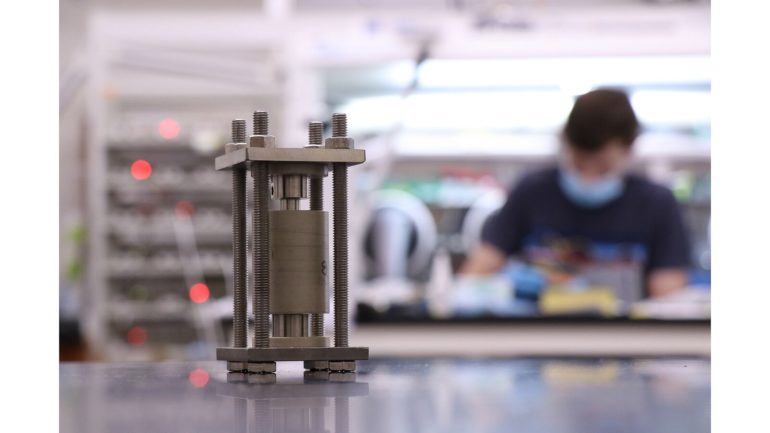Despite worldwide use of lithium batteries, the exact dynamics of their operation has remained elusive. X-rays have proven to be a powerful tool for peering inside of these batteries to see the changes that occur in real time.
Using the ultrabright X-rays of the Advanced Photon Source (APS), a U.S. Department of Energy (DOE) Office of Science User Facility at the DOE’s Argonne National Laboratory, a research team recently observed the internal evolution of the materials inside solid-state lithium batteries as they were charged and discharged. This detailed 3-D information may help improve the reliability and performance of the batteries, which use solid materials to replace the flammable liquid electrolytes in existing lithium-ion batteries.
Using a small (roughly two millimeters wide) cylindrical battery, researchers at APS beamline 2-BM were able to capture 3-D images of structural changes during the battery charge and discharge cycles as they happened.
“The main features of this beamline that made this research possible are the high sensitivity and very fast speed,” said Francesco De Carlo, group leader with Argonne’s X-ray Science division and a co-author on the paper. “The sensitivity helped the team differentiate between phases inside the battery with similar densities, and the speed allowed them to capture the changes inside the battery while the process was evolving.”
These clear images revealed how the dynamic changes of electrode materials at lithium/solid-electrolyte interfaces determine the behavior of solid-state batteries. The researchers found that battery operation caused tiny voids—resolved up to 1-2 microns in size, about 50 times smaller than the width of a human hair—to form at the interface, which created a loss of contact that was the primary cause of failure in the cells.
“This work provides fundamental understanding of what is happening inside the battery, and that information should be important for guiding engineering efforts that will push these batteries closer to commercial reality in the next several years,” said Matthew McDowell, an author on the paper and an assistant professor in the George W. Woodruff School of Mechanical Engineering and the School of Materials Science and Engineering at the Georgia Institute of Technology. “We were able to understand exactly how and where voids form at the interface, and then relate that to battery performance.”
The research was reported January 28 in the journal Nature Materials.
The lithium-ion batteries now in widespread use for everything from mobile electronics to electric vehicles rely on a liquid electrolyte to carry ions back and forth between electrodes within the battery during charge and discharge cycles. The liquid uniformly coats the electrodes, allowing free movement of the ions.
Rapidly-evolving solid state battery technology instead uses a solid electrolyte, which should help boost energy density and improve the safety of future batteries. But removal of lithium from electrodes can create voids at interfaces that cause reliability issues that limit how long the batteries can operate.
“To counter this, you could imagine creating structured interfaces through different deposition processes to try to maintain contact through the cycling process,” McDowell said. “Careful control and engineering of these interface structures will be very important for future solid-state battery development, and what we learned here could help us design interfaces.”
The Georgia Tech research team, led by first author and graduate student Jack Lewis, built special test cells which were designed to be studied at beamline 2-BM of the APS. Four members of the team studied the changes in battery structure during a five-day period of intensive experiments using X-ray computed tomography.
“The instrument takes images from different directions, and you reconstruct them using computer algorithms to provide 3-D images of the batteries over time,” McDowell said. “We did this imaging while we were charging and discharging the batteries to visualize how things were changing inside the batteries as they operated.”
Because lithium is so light, imaging it with X-rays can be challenging and required a special design of the test battery cells. The technology used at Argonne is similar to what is used for medical computed tomography (CT) scans. “Instead of imaging people, we were imaging batteries,” he said.
Because of limitations in the testing, the researchers were only able to observe the structure of the batteries through a single cycle. In future work, McDowell would like to see what happens over additional cycles, and whether the structure somehow adapts to the creation and filling of voids. The researchers believe the results would likely apply to other electrolyte formulations, and that the characterization technique could be used to obtain information about other battery processes.
De Carlo also noted that a possible next step might be nanotomography, which uses a more tightly focused X-ray beam and can deliver pictures of even smaller voids in the batteries, should they form during operation. This technique is also possible at the APS.
Battery packs for electric vehicles must withstand at least a thousand cycles during a projected 150,000-mile lifetime. While solid-state batteries with lithium metal electrodes can offer more energy for a given size battery, that advantage won’t overcome existing technology unless they can provide comparable lifetimes.
“We are very excited about the technological prospects for solid-state batteries,” McDowell said. “There is substantial commercial and scientific interest in this area, and information from this study should help advance this technology toward broad commercial applications.”
X-Ray tomography lets researchers watch solid-state batteries charge, discharge
More information:
John A. Lewis et al, Linking void and interphase evolution to electrochemistry in solid-state batteries using operando X-ray tomography, Nature Materials (2021). DOI: 10.1038/s41563-020-00903-2
Provided by
Argonne National Laboratory
Citation:
Inside the battery in 3-D: Powerful X-rays watch solid state batteries charging and discharging (2021, February 3)
retrieved 3 February 2021
from https://techxplore.com/news/2021-02-battery-d-powerful-x-rays-solid.html
This document is subject to copyright. Apart from any fair dealing for the purpose of private study or research, no
part may be reproduced without the written permission. The content is provided for information purposes only.



